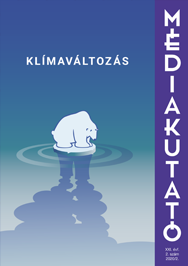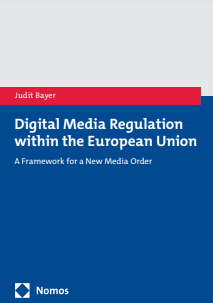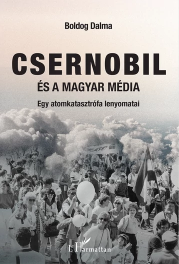Contents – Summer 2020
Vécsey, Virág:
Vécsey, Virág:
Verdure in identity, but loyal to the market: the ambigous role of Index.hu
This study examines the responsibility attribution schemes that appear in climate change news on the online news site Index. The research is based on a combined method for the comprehensive examination of the media representation of climate change, specifically developed for the research of this topic by Antal Wozniak et al. (2015). This multimodal approach explores framing, narrative and visual content at the same time. The fundamentally qualitative approach was supplemented by a quantitative element when examining frames, which also follows the methodology of previous research (Smeteko & Valkenberg 2000, Dirikx & Gelders 2010). Index focused on climate change as part of its international media collaboration, Covering Climate Now, and published 31 relevant articles of different genres during the week before the New York climate summit. The findings of the research show that most of the articles held political actors responsible for managing the consequences of climate change, but the responsibility of the individual, whose primary task according to the analysed content is conscious consumption, also comes to the fore. Through the motif of consumption, the researched content suggests that the media are also an actor in the creation of a conscious consumer who, as a subject of green governance, can be manipulated through his/her freedom of choice.
Keywords: climate change, environment, frame analysis, multimodal approach, responsibilty attribution
Verdure in identity, but loyal to the market: the ambigous role of Index.hu
Médiakutató Summer 2020 pp. 9-21
Takács, Róbert:
Takács, Róbert:
“The Good Pupil tested.” Hungarian Foreign Policy in the International Debates on Press and Media Affairs after Helsinki (1975–1983) I.
The 1975 Helsinki Final Act, the anchorage of the post-1945 European status quo was seen as the success of Soviet diplomacy. However, by declaring the free movement of people and ideas, and by admitting the respect for human rights as a basic principle of relations between states, its Basket III gave a trump card for Western powers against communist countries. Questions of information policy, including the travel opportunities and working conditions of journalists, the availability of Western press in communist countries, were also listed among these issues. These issues, which were rather unfavourable for the members of the Soviet bloc, rose to an important battlefield of the Cold War ideological struggle in international politics after 1975. This study reconstructs and analyses how Hungarian foreign policy related to these issues before and during the Belgrade conference. It examines if it was capable of transcending defensive attitudes, and whether it could insert the questions of media and information into its broader objectives within Basket III.
Keywords: availability of Western press, Belgrade conference, cold war, cultural exchange, Helsinki Final Act, Hungarian foreign policy, media relations, third basket
Médiakutató Summer 2020 pp. 25-35
Kékesdi-Boldog, Dalma:
Kékesdi-Boldog, Dalma:
How Hungarian Television reported on the Chernobyl nuclear power plant disaster
Previous research on the Hungarian media representation of the Chernobyl nuclear accident looked into written and audio sources. Findings show that in the Soviet/communist media system, the daily newspapers have only communicated the danger indirectly, with only implicit hints. Despite a few hours of censorshipfree broadcasting on Hungarian Radio, the communication of the potential health effects of the disaster was neither accurate, nor satisfactory. Using the records of Hungarian Television, this paper attempts to explore the visual communication of the disaster and tries to reveal how state television applied visual communication tools. It asks the question of whether television viewers received more factual and detailed information about the accident than newspaper readers and radio listeners did.
Keywords: Chernobyl, Hungarian information policy, Hungarian Television, nuclear disaster, Soviet/communist media system, state socialism, visual communication
How Hungarian Television reported on the Chernobyl nuclear power plant disaster
Médiakutató Summer 2020 pp. 37-55
Parapatics, Andrea:
Parapatics, Andrea:
Regional language features and their judgement in social media
This study investigates social media as a possible linguistic data source of empirical research. Since the paper draws attention to the existence of linguistic data that can be collected by passively observing digital communication, the studied sample is random and not representative. However, the information not affected by the presence of the researcher has an enormous role (beside other data garnered via different methods). This kind of reliable data is provided by the quasi faceless, oral-like, and less reflected language use on social media platforms. The study presents a great number of self-collected objective and subjective data (language facts and attitudes), highlighting that the sample shows prescriptive, one-norm language view of the users who judge and correct phonetical, syntactical and lexical regionalisms and the users of them. The paper also draws attention to the role of social media in developing metalinguistic awareness and forming attitudes by users and by direct science communication.
Keywords: dialect, dialectology, digital media, language attitude, language myths, metalinguistic awareness, mother tongue, social media, regionalism, sociolinguistics
Regional language features and their judgement in social media
Médiakutató Summer 2020 pp. 59-73
Pólya, Tamás:
Pólya, Tamás:
Can the divisive rhetoric of authoritarian political leaders be overcome?
Authoritarian political leaders’ divisive rhetoric seems to rely on our proclivities and mechanisms developed in the course of human evolution. One’s political beliefs are both fundamental to and instrumental in securing one’s attachment to a group and thus in maintaining a stable identity. That explains why humans are open to political messages that reassure them about group affiliation, so much so that it is very difficult to change their political beliefs by offering them educative facts or information different from their own views (cf. 2020, 2019). However, once the inner logic of authoritarian politicians’ hostile and divisive rhetoric is laid bare, that kind of rhetoric becomes susceptible to be dismantled and overcome by those wanting to reject it. In my previous papers, I tried to identify the main obstacles of and chances for such anti-authoritarian communicative efforts. This article specifies further crucial elements of this integrative, peaceful communication approach—e.g. addressing the whole electoral group and forming alliances that cover differing electoral views—and discusses the differences between dominant and competent leaders.
Keywords: conciliatory political rhetoric, dominance versus prestige in rank acquisition, evolutionary psychology, group cohesion, political alliances, political communication, social rank
Can the divisive rhetoric of authoritarian political leaders be overcome?
Médiakutató Summer 2020 pp. 77-87
Vicsek, Ferenc:
Vicsek, Ferenc:
Mass media versus mass informedness
The Political Propaganda Indicator (PPI) measures abuses of information management, following the models of the Democracy Index created by Freedom House and of the Corruption Perceptions Index compiled by Transparency International. It is a method for measuring how corrupted the information disseminated to the public is. The PPI shows what percentage of people accept news items spread by political propaganda as true, even though they are otherwise often difficult to verify as factually correct. It shows what share of the public has a false perception of reality because of propaganda and manipulated news services. It also shows what percentage of people fall prey to false news streams and, consequently, how many of them decide in free elections on the basis of misleading, deliberately false information or concealed information as compared to a situation in which there is a level informational playing field.
Keywords: brainwashing, fake news, information policy, informedness, media regulation, media system, propaganda, press freedom, social media
Mass media versus mass informedness
Médiakutató Summer 2020 pp. 89-103




